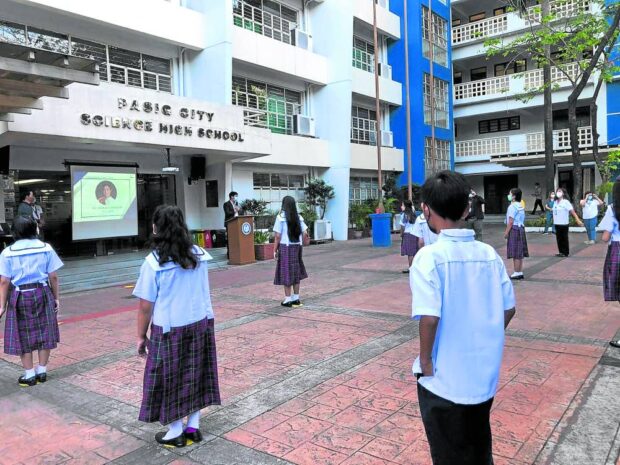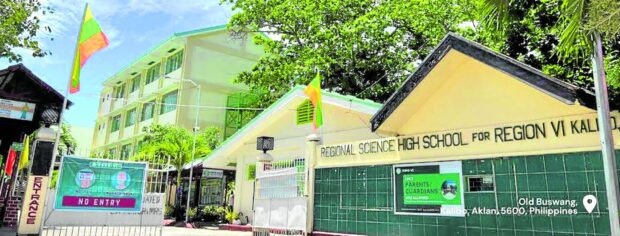Focusing on urgent education reforms

‘POSITIVE DEVIANTS’ While the country’s overall performance in the 2018 Programme for Internatonal Student Assessment (Pisa) was dismal, the Department of Education said two schools had the best scores among the Philippine Pisa participants: Pasig City Science High School and the Regional Science High School for Region VI, which is located in Kalibo, Aklan. —PHOTOS From the PCSHS and RSHS-VI Facebook pages
The result of the latest round of the Programme for International Student Assessment (Pisa) has been published by the Organization for Economic Cooperation and Development (OECD). Administered every three years, Pisa is an international benchmark of the ability of 15-year-olds to use their reading, mathematics and science knowledge and skills to meet real-life challenges.
The Philippines’ scores in Pisa 2018 were dismal. At the time, the country scored the lowest in reading comprehension for both boys and girls among 79 participating countries and economies. The same may be said for both mathematics and science, with the country scoring among the lowest in both dimensions.
In the latest assessment, the average results “were about the same as in 2018 in mathematics, reading and science,” the country note on the Philippines reads. The proportion of students who scored below the baseline level of proficiency—Level 2—did not change significantly in all dimensions, from 2018 to 2022. This is notable considering that the country underwent one of the longest lockdowns during the COVID-19 pandemic.
READ: PH education is at ‘worst state’ – PBEd on PISA results
‘Academically resilient’
There were also remarkable shifts: The gap between the most and the least socioeconomically advantaged students narrowed between 2018 and 2022, and is smaller than the average difference across OECD countries.
Some 12 percent of disadvantaged students in the country were also able to score in the top quarter of mathematics performance. Pisa describes these students as “academically resilient” because they attained educational excellence despite their socioeconomic disadvantage. This figure is higher in the Philippines compared to the OECD average, which is 10 percent.
Article continues after this advertisementData from the Pisa 2022 results also show that 36 percent of students were in the bottom international quintile of the socioeconomic scale, meaning they were among the most disadvantaged students who took the test, among the 85 countries who took part in the assessment.
Article continues after this advertisement
Regional Science High School for Region VI
READ: Bongbong Marcos signs laws for 7 higher education institutions
Bright spots
There are bright spots, however, despite the sobering results of international benchmarks. Among public schools in the Philippines, two schools shine in this regard: Pasig City Science High School (PCSHS), and Regional Science High School for Region VI (RSHS-VI). Both schools were identified by the Department of Education as the top performers in Philippine Schools in Pisa 2018.
PCSHS sets high academic expectations and standards for its students, with its Pasig Science Admission Test serving as a monitoring tool to measure the performance of the school against expectations and standards in division, regional, national, and even international levels. The school has also adopted a pedagogy that is both “student-centric and ICT-enhanced,” encouraging deep learning, critical thinking, and creativity among its students.
At RSHS-VI, top performers of the class are encouraged to guide their fellow students through hard lessons through peer mentoring. Alumni of the school are also invited to join this coaching system to help graduating students at RSHS-VI prepare for entrance exams in college.
As we further study the 2022 Pisa results, the Second Congressional Commission on Education (Edcom 2) plans to visit these positive deviants in both years—schools and learners that succeeded despite the odds—to identify interventions that could be supported by the government and scaled to other schools.
Pisa 2022 and after
Stories from PCSHS and RSHS-VI, and from teachers who participate in our consultations on the ground at Edcom 2 give us hope. But hope must also move us to action.
The Department of Education’s current initiatives and programs are on the right track. Firstly, we need to urgently ramp up the National Learning Recovery Programs, in a way that ensures we are targeting the learners that need the most support and that follows the principles of TARL, or teaching at the right level. This is critical, especially in Key Stage 1 (Kinder to Grade 3).
There must also be increased vigor in attending to early childhood education and the nutritional needs of children between ages 0 and 4. Data has shown that focusing on this crucial window translates to improved participation, completion and achievement of learners. In fact in the 2022 Pisa, students who attended pre-primary education for at least one year were found to be significantly less likely to repeat a grade at any level compared to those who never attended or attended for less than a year, even when considering socioeconomic factors.
We also need to let the (right) teachers teach—that is, addressing the mismatch in the specialization of what teachers are trained for and what they teach, resolving the problem of teachers being overburdened with ancillary tasks, and ensuring access to quality teacher training and coaching.
Books, classrooms
Lastly, we must work together to find adaptive solutions to long-standing issues like textbooks and congestion.
In Edcom’s analysis of DepEd data, only 27 textbooks have been procured since 2012, with only Grades 5 and 6 students having complete textbooks for all subjects. As Edcom works with DepEd in finding solutions to these procurement challenges, the commissioners have urged the department to explore alternative resources, such as digital media. DepEd could also look into alternate learning resources such as teacher guides and activity sheets to ensure that we are ready by the time we implement Kinder, Grades 1, 4 and 7 by August 2024. On the other hand, classroom congestion may be partly addressed by targeting student vouchers in areas that have high student-classroom ratios. For example, our analysis shows that there are 149 municipalities with very congested Junior High School but have very low or no presence of ESC private schools.
One thing is clear: we cannot be business as usual. We need to work on long-term structural reforms while also addressing urgent, low-hanging solutions that can impact learners currently in our classrooms. Learning recovery initiatives, early childhood education and nutrition interventions for the early years, and teacher education and development are necessary investments we need to make to secure a brighter future for Filipino learners.
(Dr. Karol Mark Yee is the executive director of the Second Congressional Commission on Education [Edcom 2] that is undertaking a comprehensive assessment of the country’s education sector.)